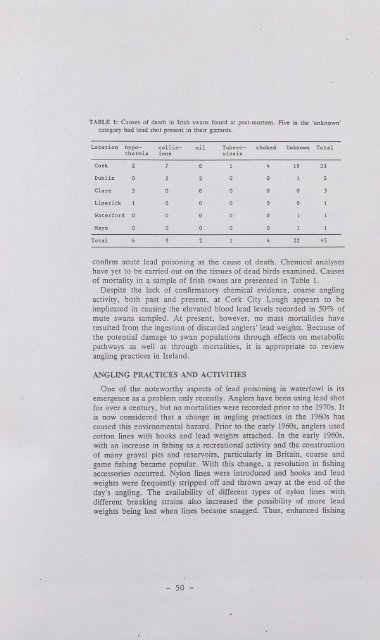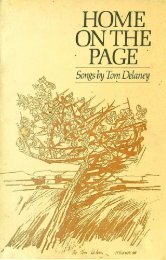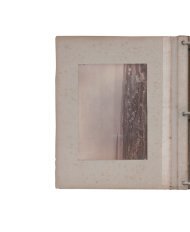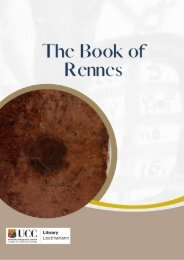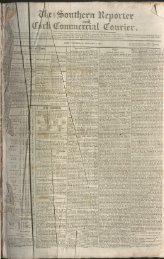Lead Toxicity in Mute Swans
LEAD TOXICITY IN MUTE SWANS Cygnus olor (Gmelin). By JOHN O'HALLORAN A thesis submitted to the National University of Ireland in candidature for the degree of Doctor of Philosophy September 1987
LEAD TOXICITY IN MUTE SWANS
Cygnus olor (Gmelin).
By
JOHN O'HALLORAN
A thesis submitted to the National University of Ireland
in candidature for the degree of Doctor of Philosophy
September 1987
Create successful ePaper yourself
Turn your PDF publications into a flip-book with our unique Google optimized e-Paper software.
TABLE 1: Causes of death <strong>in</strong> Irish swans found at post-mortem. Five <strong>in</strong> the 'unknown'<br />
category had lead shot present <strong>in</strong> their gizzards.<br />
Location hypo- coll is- oil Tuberc- choked Unknown Total<br />
thermia ions ulosis<br />
Cork 2 0 4 19 33<br />
Dubl<strong>in</strong> 0 2 2 0 0 s<br />
Clare 3 0 0 0 0 0 3<br />
Limerick 0 0 0 0 0<br />
Waterford 0 0 0 0 0<br />
Mayo 0 0 0 0 0<br />
Total 6 9 2 4 22 45<br />
confirm acute lead poison<strong>in</strong>g as the cause of death. Chemical analyses<br />
have yet to be carried out on the tissues of dead birds exam<strong>in</strong>ed. Causes<br />
of mortality <strong>in</strong> a sample of Irish swans are presented <strong>in</strong> Table 1.<br />
Despite the lack of confirmatory chemical evidence, coarse angl<strong>in</strong>g<br />
activity, both past and present, at Cork City Lough appears to be<br />
implicated <strong>in</strong> caus<strong>in</strong>g the elevated blood lead levels recorded <strong>in</strong> 50% of<br />
_mute swans sampled. At present, however, no mass mortalities have<br />
resulted from the <strong>in</strong>gestion of discarded anglers' lead weights. Because of<br />
the potential damage to swan populations through effects on metabolic<br />
pathways as well as through mortalities, it is appropriate to review<br />
angl<strong>in</strong>g practices <strong>in</strong> Ireland.<br />
ANGLING PRACTI.CES AND ACTIVITIES<br />
One of the noteworthy aspects of lead poison<strong>in</strong>g <strong>in</strong> waterfowl is its<br />
emergence as a problem only recently. Anglers have been us<strong>in</strong>g lead shot<br />
for over a century, but no mortalities were recorded prior to the 1970s. It<br />
is now considered that a change <strong>in</strong> angl<strong>in</strong>g practices <strong>in</strong> the 1960s has<br />
caused this environmental hazard. Prior to the early 1960s, anglers used<br />
cotton l<strong>in</strong>es with hooks and lead weights attached. In the early 1960s,<br />
with an <strong>in</strong>crease <strong>in</strong> fish<strong>in</strong>g as a recreational activity and the construction<br />
of many gravel pits and reservoirs, particularly <strong>in</strong> Brita<strong>in</strong>, coarse and<br />
game fish<strong>in</strong>g became popular. With this change, a revolution <strong>in</strong> fish<strong>in</strong>g<br />
accessories occurred. Nylon l<strong>in</strong>es were <strong>in</strong>troduced and hooks and lead<br />
weights were frequently stripped off and thrown away at the end of the<br />
day's angl<strong>in</strong>g. The availability of different types of nylon l<strong>in</strong>es with<br />
different break<strong>in</strong>g stra<strong>in</strong>s also <strong>in</strong>creased the possibility of more lead<br />
weights be<strong>in</strong>g lost when l<strong>in</strong>es became snagged. Thus, enhanced fish<strong>in</strong>g<br />
- 50 -<br />
./


